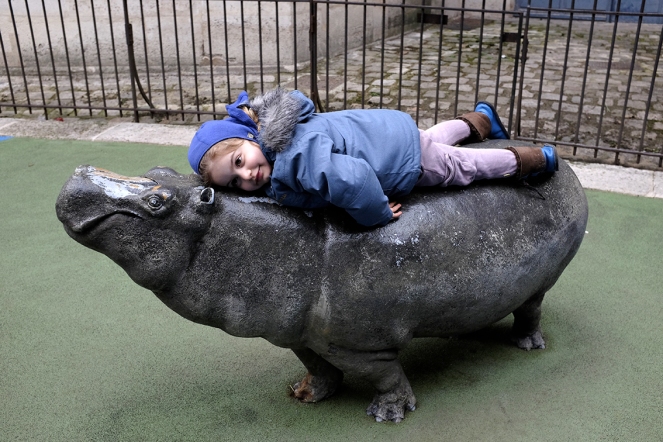 HOW TO TEACH YOUR KIDS ABOUT WILDLIFE CONSERVATION
HOW TO TEACH YOUR KIDS ABOUT WILDLIFE CONSERVATION
You probably heard about the death of Sudan, the LAST male northern white rhinoceros. Or that giraffes are now on the endangered species list. But what you probably didn’t know is that, every year, at least 10,000 species become extinct! So how can we teach our kids to take a better care of the planet than we are doing right now?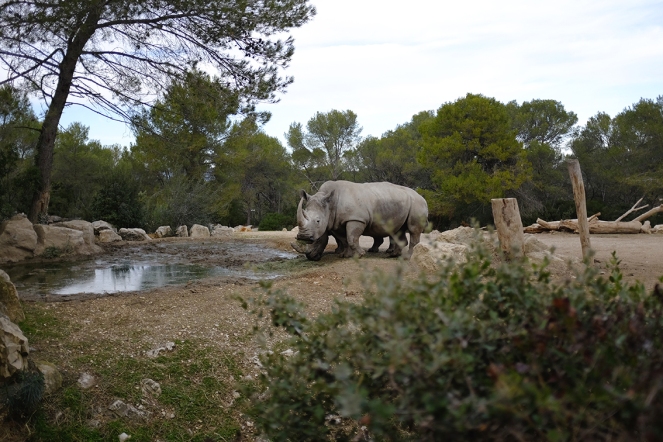 There are a myriad of ways to expose children to the ideas of wildlife protection and here are just a few suggestions:
There are a myriad of ways to expose children to the ideas of wildlife protection and here are just a few suggestions:
- Actively engage your child in activities outdoors. (See the list of activities below).
- Buy local food and engage your child in the process of buying it. Go to local markets and talk to farmers. Let your child touch and pick seasonal food.
- Model empathy and compassion. For example – do NOT kill insects. If you really must kill a mosquito or a redback spider in front of a small child, then “catch it” instead. Most insects are harmless and should be caught and released. Also, when walking, point out ants and other small creatures and show your child how to walk around them as not to hurt them!
- You can explain how animals are taken from their homes and sold to circuses or zoos. Avoid mentioning animal death until your child is emotionally ready (read below).
- When age appropriate, Discuss threats to animals and their environment (deforestation / habitat destruction and human impact on the environment, for example).
- Invite your child to brainstorm solutions for how they can create positive change now.
- Discuss conservation topics with friends.
- Do not litter and pick up plastic bags and other trash whenever possible.
- Teach children how to preserve life by rescuing animals. (Read our animal rescue stories below).
- Start your ant colony!
- Offer books that talk about wildlife conservation. (Check out our favorites below).

WHY YOU SHOULD NOT MENTION ANIMAL DEATH AROUND CHILDREN
Most kids under 3 do not understand the idea of irreversibility (death) and, honestly, there is absolutely NO need talk to any child about dying animals, poaching, killing, guns, etc. until they are developmentally ready for these conversations – usually around 11 or 12 years of age. Of course each child is different, but don’t destroy your kid’s innocence too early. They will have plenty of time to learn these things as they grow anyway.
Talking about things that are not developmentally appropriate, will not only desensitize the child, but create anxiety because children do not have enough emotional intelligence to process that information. Plus, it takes them out of the present moment and childhood should really all be about “now.” Let them enjoy the innocence for as long as they can.
ACTIVITIES TO TEACH CHILDREN THE IMPORTANT OF WILDLIFE CONSERVATION
- Watch insects and teach your kids how NOT to hurt them. Small children usually don’t have good control over their movements so it’s important to model proper insect handling and empathy to them. For example, when Adèle was 3 she asked “to feel ants.” I explained that animals usually do not like it when we touch them, but instead we should allow animals to approach us, if they so choose. So, she put a finger on the ground and ants came to touch her instead. She said they felt as soft as a plush toy. I had to remind her frequently not to wiggle too much as not to hurt the ants, but she was watching and playing and talking with them for a very long time. She says they are her friends!

Adèle made a tunnel for ants to go under. - Watch birds.
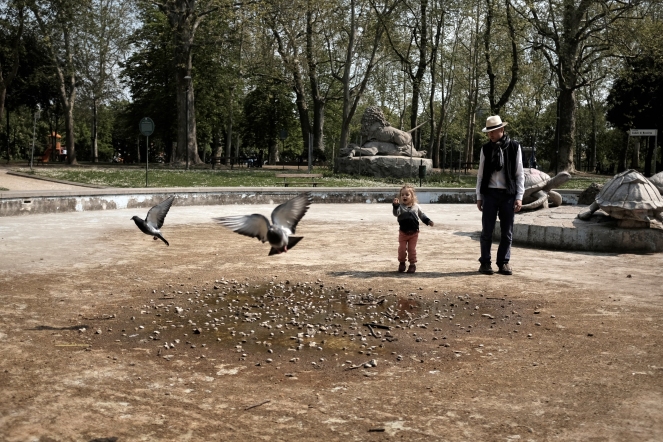
Watching pigeons at a park in Bologna, Italy - Look for slugs, snails and worms, especially after the rain.
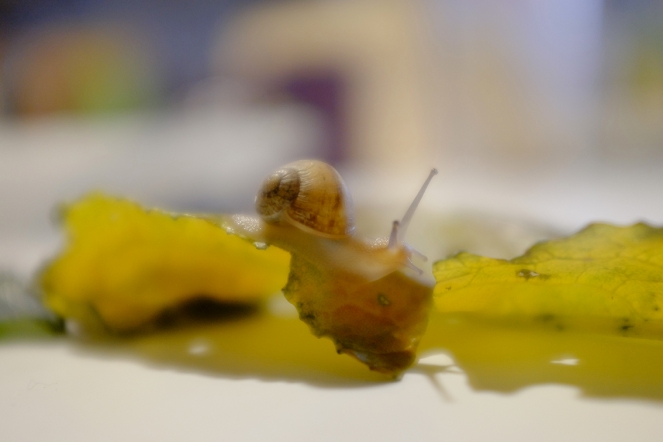
- If you don’t live near nature, take trips to see animals in the wild.

Watching a wild horse nursing a foal! - Many zoos offer wildlife conservation programs for kids which are designed to raise their awareness about the environment. Many even have up-close and personal encounters with endangered animals.

Feeding a Giraffe at the Adelaide Zoo in South Australia 
Watching a Koala eat eucalyptus leaves at the Cleland Wildlife Park in South Australia - Aquariums also often offer educational experiences.

Adèle touching a very friendly ray at the Aquarium in Montpellier, France - Check your organic produce for mysterious visitors. We found this one in the fridge! Read it’s rescue story below. 😉

We found a snail on our kale! (Kale came from a farmer’s market). - Take your child to petting zoos.

- Farms are also a great place to sensitize your child to animals. Many have baby animals that can be petted.
- Offer pony, horseback or camel riding lessons. This way your child will learn about the behavior of animals as well as how to take care of them.

Riding a poney at the Le Petit Paradis De Vendargues in France - RESCUE ANIMALS no matter how small they are. In the last year alone we saved 5 so far. You can read about all our rescue missions of the year below!
***Disclaimer: This post contains affiliate links, and if you decide to purchase anything from suggested links or companies, I may receive a commission. Recommended products are either things I love using or think would be helpful for you. Making your purchase using these affiliate links helps keep this site running, so thank you kindly!
BOOKS THAT WILL INSPIRE KIDS TO BE NATURALISTS, CONSERVATIONISTS OR ENVIRONMENTAL ACTIVISTS
I love the following books for their strong female protagonist. As a positive role models, Jane Goodall empowers little girls and boys alike to protect nature. All three of these books recount her awe-inspiring biography and life with chimps. Adèle now says she is also “a watcher,” so mission accomplished. 😉 (For those who are curious, in this photo she is using a brand of French binoculars similar to Kids Binoculars, but there are others that are appropriate for different ages that I reviewed below.)

- I am Jane Goodall (Ordinary People Change the World) by Brad Meltzer and Christopher Eliopoulos – This book is illustrated with speech bubble and, thus, has a comic-book like feel. Written in first person for elementary school-aged children, it really captures poignant moments in Jane’s life’s adventures. The message of this book is that “we can accomplish anything by working together.” There is one part that mentions how women should not be alone in the forest, but you can always skip over that while reading to avoid reinforcing gender stereotypes. Otherwise, it’s a very thorough, well written book that will definitely appeal to young readers.
The Watcher: Jane Goodall’s Life with the Chimps
by Jeanette Winter – This book is for preschoolers and elementary aged-school children. It covers all the highlight’s of Jane’s life and introduces the concepts of wildlife conservation without going too much into details like the above-mentioned book. There is a scene with guns and poachers and I usually do NOT read the part that talks about “killing” chimps. If your child asks what the guns are, you can say they are tools to capture animals. There is really no need to go into details unless the child keeps on pressing for more and more information. With this said, it’s one of Adèle’s favorite books and describing Jane as a “watcher” is very inspiring for young children. It will help your child relate to the character and inspire them to also watch creatures around them.
- Me . . . Jane buy Patrick McDonnell – The text in this books is more simple and only focuses on the story of Jane Goodall’s childhood. Stylistically, the illustrations are also geared towards smaller children and it is designed as a bedtime story. I recommend this one for preschoolers.
The following books are wordless picture books that open up the conversation about ecology.
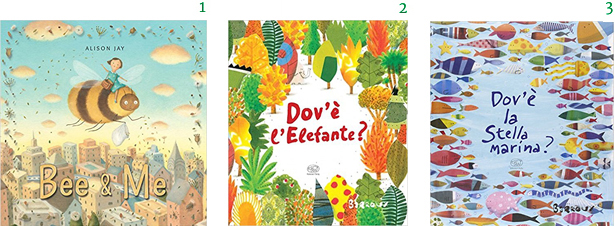
- Bee & Me
by Alison Jay- A girl becomes friends with a bee and they go on a journey together. Along the way they help children realize how they can contribute to conservation.
- Dov’è l’elefante (Where is the elephant?) by Barroux – A simple question encourages the child to find the elephant and his two friends and also serves to raise awareness for the respect for the environment. Inspired by deforestation of the Brazilian rain forest, this simple yet powerful story is not to miss.
- Dove’è la stella marina? by Barroux – Same concept and illustration style as above, but about marine pollution. The child looks for the star fish, the jellyfish and the clown fish as the ocean gets dirtier and dirtier with all the garbage humans put inside. Luckily, nature finds a way to fight back.
 Life in the Ocean: The Story of Oceanographer Sylvia Earle by Claire A. Nivola
Life in the Ocean: The Story of Oceanographer Sylvia Earle by Claire A. Nivola – I’d also like to recommend this book because a) it has a very strong female role model who followed her childhood passions to explore and protect the oceans and b) it is based on a true person’s journey.
SIMPLE TOYS FOR OUTDOOR EXPLORATION

- Kidwinz Shock Proof 8×21 Kids Binoculars – small size make it easy for preschoolers to hold and look through. They are also shockproof.
Educational Insights GeoSafari Jr. Kidnoculars – these ones do NOT need to be focused so are perfect for toddlers and small children. All your child needs to do is just look through them! Simple, fun and shock proof!
EvoCrest Binoculars for Kids
– Shockproof and also designed specifically for kids. They have the same high resolution as the first set I mentioned above.
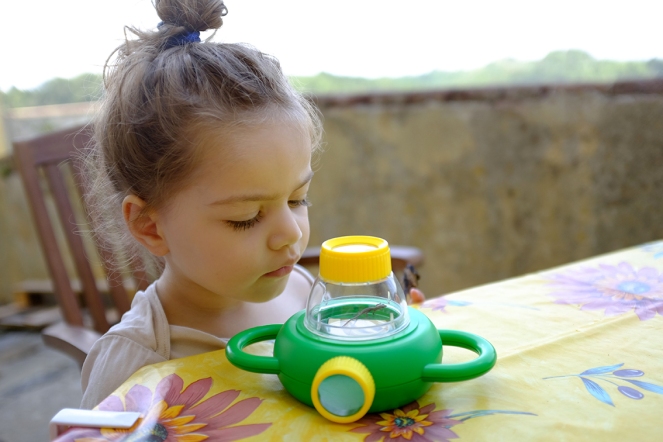 And here is another fun toy Adèle likes. It’s a Edu-Toys Two Way Bug Viewer, 4x, 6x
And here is another fun toy Adèle likes. It’s a Edu-Toys Two Way Bug Viewer, 4x, 6x, but as you can see in the photo above, she was even lucky enough to fit a small gecko inside! It has two lenses (top and side) to watch from and is easy for little hands to hold and use.
Sometimes she uses the top part of the lens by itself by putting it against a plant or over bugs, as in the photo above. This way she doesn’t need to catch anything and uses it more like a magnifying glass.
WHAT RESCUING ANIMALS WILL TEACH YOUR CHILD
- Empathy – Ability to feel someone else’s emotions
- Compassion – Empathy plus a desire to help
- Nutrition – Often, to save them, you will need to research what to feed rescued animals.
- Habitat – When releasing an animal back into the wild, you will need to learn where, when and how to do it.
- Identifying animals
- How to take care of another being
Here are a few animals we rescued over the last year and their stories. I hope they will inspire you to be aware as you walk or drive outside.
SUSHI

We found this adorable kitten at one of the busiest roundabouts in the center of Tbilisi, Georgia and had no choice but to take it with us. Luckily (and not by accident), there were at least 3 pet shops across the street so we immediately took Sushi there and asked if we could leave him. They said that they already had enough cats and that you can’t just drop off lost animals like that at a shop, nor at the vet’s (a big shock for us as that’s what we used to do in Australia). So we had him checked and treated for lice. He was too small to have rabies shots but seemed in excellent health. A vet later confirmed that indeed, he was in perfect health and that it looked like someone had dropped him off at the roundabout on purpose. He knew how to use a litter box and once well fed, became a very active, lively kitten. We had Sushi for 10 days before I managed to find a loving forever home for him. We were all very sad and had a big cry after he left, but with our nomadic lifestyle there was no way for us to keep him. We do keep in touch with his owner, though, and get occasional photos.
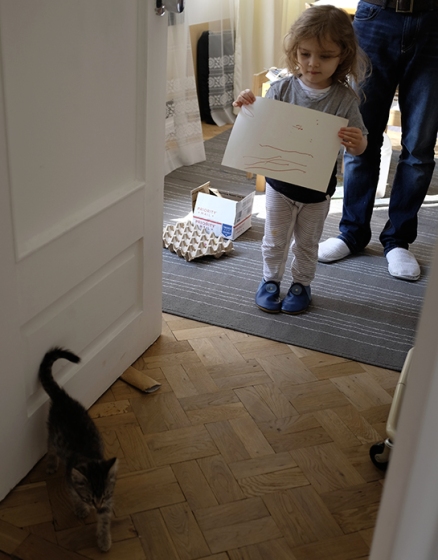
Things we learned from kitten rescue
- Adèle learned how to scrunch up paper and make a toy for the kitten.
- She learned how cats eat, pee and poo – that helped with her own potty learning.
- We also taught her about anticipated cat behavior so that she wouldn’t get scratched. This was important because, being a street cat, we did not know if it had rabies and had to wait for 10 days to find out. This taught her to be gentle and careful around animals.
FIG FROG
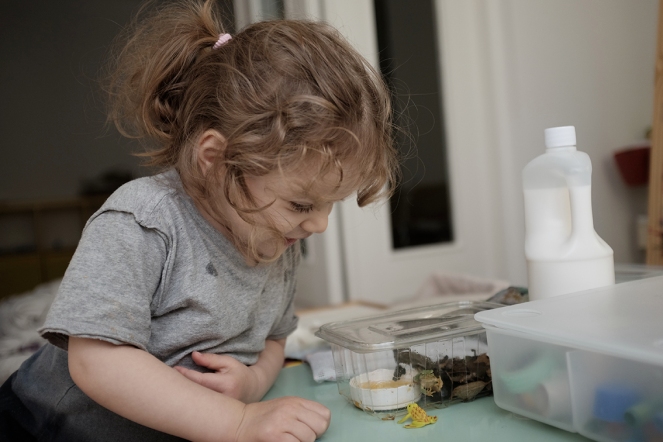
One evening, my husband found fig frog in food at an organic shop, once again in Tbilisi, Georgia. It was also in the middle of the city center, so the only option was to take it home. The shop keeper gave him this plastic box and we put some holes in it so that it could breath. We put some leaves inside and a bit of water as well. Adèle introduced it to her toy frog so that it could keep him company overnight. We lived right under a mountain, but it was too late to go there, so we had to wait until the morning to release the frog. When we woke up in the morning, the plastic box was covered with very gross yellowish substance.
 I think the frog was not very happy being trapped inside for this long. So, we hiked up the mountain to look for a stream. Here is a photo of Fig Frog jumping off the box to find a new home. Follow Adèle’s finger in the photo to find him at the edge of the box, about to leap into the water.
I think the frog was not very happy being trapped inside for this long. So, we hiked up the mountain to look for a stream. Here is a photo of Fig Frog jumping off the box to find a new home. Follow Adèle’s finger in the photo to find him at the edge of the box, about to leap into the water.

Things we learned from frog rescue
- Release the frogs into the wild as soon as possible so that they can jump around!
- If you cannot release the frog right away, find some insects to feed it.
MERLY

I saw a baby blackbird as we were driving in Italy and asked to stop the car. It had fallen from a nest and the trees were very high, so there was no way we could put it back. Luckily, there were no cars on the road so we stopped and caught it in a scarf. It was a baby blackbird that fell out of the nest and we took it home. After doing some research online, it turned out that blackbirds like to eat meat and watermelon so that’s what we fed it. The next day we drove him to a bird rescue Aviary in Livorno. It was a big drive for Adèle, but we were happy that the vet found Merly in good health. They took him in and placed him into a bird nursery. There, it was taught how to fly and was released back into the wild a month later!!

Things we learned from bird rescue
- Make sure you know what to feed the bird – identify the species to feed it correctly. The vet told us that had we not fed it properly, it might not have survived at all! And had we not picked him up from the road, it would have been eaten by a cat or a wild animal. Life expectancy of a baby bird fallen from a tree is very short.
- Place a bird in a box. If it can fly, then make holes in a closed box.
- Catch birds with cloth, scarves, sweaters.
CRICK-CROCK HERRISON

This adorable hedgehog was crossing a road at night and seemed lost, so we took him in for the night. Luckily, one of my former student’s knows a lot about hedgehogs and I reached out to her for advice. She said that it seemed healthy and could be released back into the wild, so we did that the next morning. But I did not sleep a wink during the night! It is THE noisiest animal in the world! I had to sleep at the other side of the house and still heard it making noises all night. It didn’t like being in a box and wanted to escape.
Things we learned from hedgehog rescue
- Hedgehogs are nocturnal animals and are EXTREMELY NOISY AT NIGHT!
- Their spikes are a bit soft, so they can be petted gently.
SNAILY

I found Snaily on our kale as I took it out of the refrigerator! It was happy to be out of the cold and was not scared at all.

On one of our walks, Adèle once noticed that some snails had made houses in arrow loops of castle walls. (This is where archers used to fired arrows from). So she suggested that we take Snaily there so that it can live with his new friends. When we returned the next day, it was not there anymore. But once in a while we see a snail in the loopholes and she thinks it might be Snaily. 😉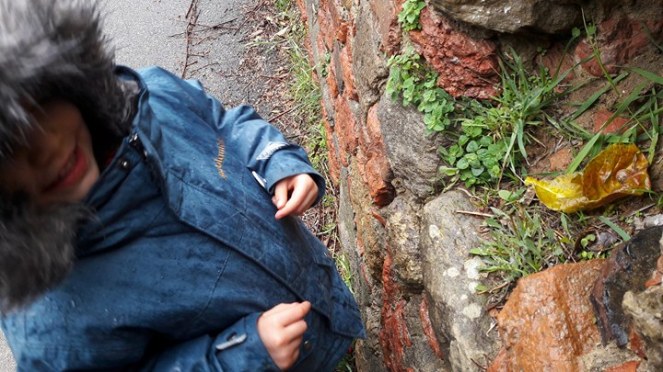
Things we learned from snail rescue
- Even tiny creatures can be rescued.
- Snails leave a silvery trail
behind them.
Have your rescued any animals? I’d love to hear your stories!







This literally blew my mind. 10000 EVERY year?!
LikeLike
Alas, it’s true. Most of that number are the insects, but if insects disappear, so will the rest of the ecosystem.
LikeLike
Great list of ideas. I can’t wait for my daughter to be old enough to go to petting zoos and do other animal activities. 🙂
LikeLike
Love this! Empathy should be nurtured just like you nurtured these lovely little animals. I love what you are instilling on your little angel girl ❤
LikeLike
❤
LikeLike